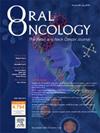Margin-to-depth ratio as an independent prognostic factor in resected oral cavity squamous cell carcinoma: A nationwide cohort study
IF 4
2区 医学
Q1 DENTISTRY, ORAL SURGERY & MEDICINE
引用次数: 0
Abstract
Background
The prognostic significance of margin-to-depth ratio (MDR) in oral cavity squamous cell carcinoma (OCSCC) remains unclear, particularly in comparison to traditional margin status. We aimed to examine the association between MDR and clinical outcomes in a large Taiwanese cohort.
Methods
A total of 18,324 patients with first primary OCSCC were categorized by margin status: positive (1013), <5 mm (8371), and ≥ 5 mm (8940). Disease-specific survival (DSS) and overall survival (OS) served as the main outcome measures.
Results
After excluding patients with positive margins (MDR = 0), the optimal MDR cutoff value for DSS and OS was 0.6. Patients with MDR > 0.6 showed significantly better 5-year DSS and OS rates (87 %, 81 %) compared to those with MDR ≤ 0.6 (71 %, 63 %) and MDR = 0 (53 %, 43 %). Multivariable analysis identified MDR ≤ 0.6 as independently associated with both DSS and OS in the entire cohort (hazard ratio [HR] = 1.34/1.32). This finding was consistent in the subgroups with surgical margins < 5 mm (HR = 1.39 for DSS and 1.38 for OS) and margins ≥ 5 mm (HR = 1.21 for both DSS and OS). In subgroups with surgical margins < 5 mm and ≥ 5 mm, an MDR > 0.6 was associated with better survival outcomes.
Conclusions
An MDR (cutoff: 0.6) is independently associated with prognosis in OCSCC, offering improved risk stratification compared to margin status alone. While MDR may guide surgical margin modification, further research is needed to determine whether MDR could serve as a postoperative indicator for adjuvant therapy in patients with close or clear margins.
切除口腔鳞状细胞癌的边缘深度比作为独立预后因素: 一项全国性队列研究。
背景:口腔鳞状细胞癌(OCSCC)边缘深度比(MDR)的预后意义仍不明确,尤其是与传统的边缘状态相比。我们的目的是在一个大型台湾队列中研究 MDR 与临床预后之间的关系:方法:共对 18,324 例首次原发性 OCSCC 患者按边缘状态进行了分类:阳性(1013 例)、阴性(1013 例)、阳性(1013 例)、阴性(1013 例)和阳性(1013 例):排除边缘阳性(MDR = 0)患者后,DSS 和 OS 的最佳 MDR 临界值为 0.6。与 MDR ≤ 0.6(71%,63%)和 MDR = 0(53%,43%)的患者相比,MDR > 0.6 的患者的 5 年 DSS 和 OS 率明显更高(87%,81%)。多变量分析发现,在整个队列中,MDR≤0.6与DSS和OS均有独立相关性(危险比[HR] = 1.34/1.32)。这一结果在手术切缘为0.6的亚组中也是一致的,因为0.6与更好的生存结果相关:结论:MDR(临界值:0.6)与OCSCC的预后密切相关,与单纯的边缘状态相比,MDR能更好地进行风险分层。虽然MDR可以指导手术切缘的修改,但还需要进一步研究,以确定MDR是否可以作为切缘紧密或清晰患者术后辅助治疗的指标。
本文章由计算机程序翻译,如有差异,请以英文原文为准。
求助全文
约1分钟内获得全文
求助全文
来源期刊

Oral oncology
医学-牙科与口腔外科
CiteScore
8.70
自引率
10.40%
发文量
505
审稿时长
20 days
期刊介绍:
Oral Oncology is an international interdisciplinary journal which publishes high quality original research, clinical trials and review articles, editorials, and commentaries relating to the etiopathogenesis, epidemiology, prevention, clinical features, diagnosis, treatment and management of patients with neoplasms in the head and neck.
Oral Oncology is of interest to head and neck surgeons, radiation and medical oncologists, maxillo-facial surgeons, oto-rhino-laryngologists, plastic surgeons, pathologists, scientists, oral medical specialists, special care dentists, dental care professionals, general dental practitioners, public health physicians, palliative care physicians, nurses, radiologists, radiographers, dieticians, occupational therapists, speech and language therapists, nutritionists, clinical and health psychologists and counselors, professionals in end of life care, as well as others interested in these fields.
 求助内容:
求助内容: 应助结果提醒方式:
应助结果提醒方式:


